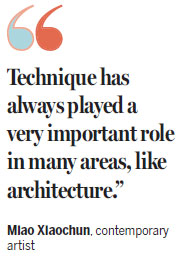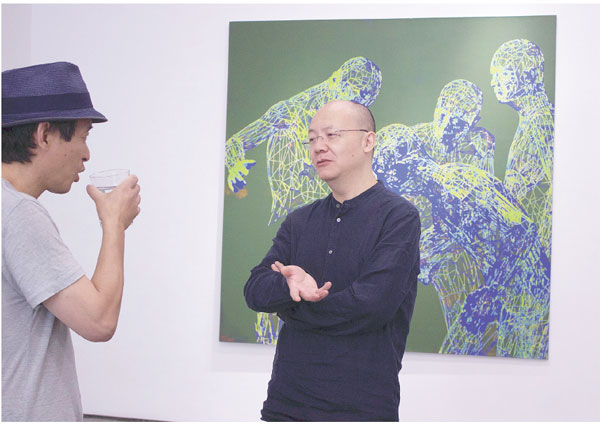Artist calls on 3d software as medium
Updated: 2016-10-10 11:01
By Hong Xiao in New York(China Daily USA)
|
||||||||
"Technology has been applied invarious domains, so why not in arts?" said Miao Xiaochun, as he sat leisurely at the Klein Sun Gallery near the High Line park in New York, where the Chinese contemporary artist's solo exhibition is showing.
As opposed to typical artist tools like brushes, pencils or just hands, Miao has adopted 3D software as his artistic medium.
The exhibition, titled Metamorphosis, reflects the artist's commitment to the new form of painting and expression. The show presents a series of Miao's recent works, based on his research of digital media since 2008.
The works collectively present the transformation between motion image and works on paper and explore issues of the real and the virtual, the traditional and the contemporary, and the human and the technological.
|
The artist Miao Xiaochun talks with a visitor at his solo exhibition Metamorphosis at the Klein Sun Gallery in New York. Hong Xiao / China Daily |
Works shown in the exhibition such as Zero Degree Doubt embody the artist's continuing attempt to reform the language in paintings.
The work is based on Doubting Thomas, a classic piece of art, which depicts a skeptic who refuses to believe in resurrected Jesus until he could see the wounds. In this work, the artist replaces the characters with crystal virtual figures and transparent bodies.
In the video, the moment the skeptic touches the suspect, the suspect's body shatters instantly. Miao tests the notion of faith and belief in the context of modern society in his work.
Born in 1964 in Wuxi, East China's Jiangsu province, Miao now lives and works in Beijing. He studied at the Central Academy of Fine Arts in Beijing and the Kunsthochschule in Kassel, Germany.
As a student at Kunsthochschule, Miao said he was profoundly moved by William Kentridge's works at Documenta in 1997, when the idea of working with animation first occurred to him.
In 2004, Miao began to experiment with 3D software, which led to the creation of The Last Judgment in Cyberspace, the artist's first work exclusively created with 3D techniques. Since then, Miao has been delving into the transformative expression between 3D motion and paintings.
By altering oil paintings from the Renaissance period, Miao introduced 3D methods into practice, reinterpreting the classic narratives presented in the masterpieces.
In his previous work, The Triumph of Death, Miao references a painting by Pieter Brueegel in 1562, turning the panorama of war into a film set and filling the painting with virtual characters of himself.
At the same time, inspired by Henri Matisse's cutout, Miao introduced the concept of Computer Fauvism into this work. Operating a cutting plotter and lettering paper, the artist gives the painting a wide spectrum of colors, creating a dazzling and chaotic scene and rewriting the theme of death in the original work.
Continually discovering the possibility of new media in paintings, Miao incorporates 3D modeling, cutting plotters and hand drawing, creating a new category of painting defined as "algorithmic painting".
Primarily using a computer to generate graphics and models, the artist then handdraws the 3D images on canvas, working harmoniously with computer technology and seamlessly transferring the virtual world onto twodimensional papers.

Miao's recent solo exhibitions include Macromania, at the Ludwig Museum in Koblenz, Germany (2010), and Miao Xiaochun-Two Big Video Works, at the Today Art Museum, in Beijing (2010).
His recent group shows include Screen Play: Life in an Animated World, at the Albright-Knox Art Gallery, in Buffalo, New York (2015); China 8: Contemporary Art from China on the Rhine and Ruhr, Kunstmuseum Gelsenkirchen, in Gelsenkirchen, Germany; and Future Returns: Contemporary Art from China, at the Eli and Edythe Broad Art Museum, in East Lansing, Michigan.
Miao's work is included in permanent museum collections worldwide, including the M+Sigg Collection, Hong Kong, and the Museum of Modern Art, New York.
To Miao, using technology to create art is a process of discovery.
"Technique has always played a very important role in many areas, like architecture. Without precise calculation, it would not work," Miao said.
"And people may not know that technique has a far-reaching influence in creating artworks," Miao told China Daily.
"Back to the Renaissance period, artists learned to paint the perspective, the shades by calculating. Those are all techniques," he said.
"The only difference is I use the technique of computer to create arts," he added.
"You have to dive into the pool first, then you can learn how to swim," Miao said.
xiaohong@chinadailyusa.com
(China Daily USA 10/10/2016 page10)
- Panel tackles controversial Fox News skit on Chinatown
- Chinese tourists forced to sleep at airport for 5 days
- Saudi-led coalition denies striking funeral in Yemen's capital
- From bars to shops, seniors working in Tokyo
- Boat with some kids aboard capzised in San Francisco
- China urges G20 to implement Hangzhou consensus

 Egrets Seen in East China's Jiangsu
Egrets Seen in East China's Jiangsu
 Highlights of Barcelona Games World Fair
Highlights of Barcelona Games World Fair
 Coats, jackets are out as cold wave sweeps in
Coats, jackets are out as cold wave sweeps in
 6 things you may not know about Double Ninth Festival
6 things you may not know about Double Ninth Festival
 Double Nineth Festival: Can you beat these elders?
Double Nineth Festival: Can you beat these elders?
 Replica of Eiffel Tower glows in E China's Hangzhou
Replica of Eiffel Tower glows in E China's Hangzhou
 8 things you may not know about Cold Dew
8 things you may not know about Cold Dew
 Chinese designer's work shines at Paris Fashion Week
Chinese designer's work shines at Paris Fashion Week
Most Viewed
Editor's Picks

|

|

|

|

|

|
Today's Top News
Trump outlines anti-terror plan, proposing extreme vetting for immigrants
Phelps puts spotlight on cupping
US launches airstrikes against IS targets in Libya's Sirte
Ministry slams US-Korean THAAD deployment
Two police officers shot at protest in Dallas
Abe's blame game reveals his policies failing to get results
Ending wildlife trafficking must be policy priority in Asia
Effects of supply-side reform take time to be seen
US Weekly

|

|
